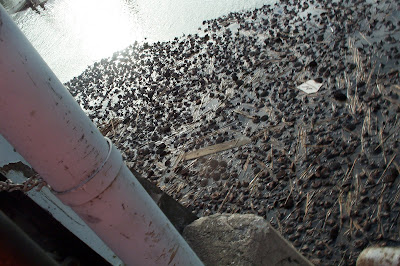
There's lots of weeds, cattails and other plants in the protected cove. The power plant also has a huge net and "fish trap" to keep their pipes clear of debris. One day i saw thousands and thousands of little 4" fish, shad i think, that had completely filled the hanging metal basket.

In September i was there and in the bay there were these huge lillypads, they looked to be 3 feet in diameter. You can see that they took up half the channel.

I took this picture with my cell phone. In early November, that month the fog seemed to stay there every morning.

Later in the year around November, all of the lillypads were gone and these brown, round floating things with seeds in them were in their place...and lots of trash because it's Lake Erie.


At the time i wasn't sure exactly what they were but i liked them and brought home a handful of seeds. I found out later that the plant and seed pod were from the American Lotus.
I then read that:
- It's the only native lotus species to the U.S. and Canada
- Native Americans used to eat the seeds and rhizomes (roots)
- The plant is a good "indicator" species and only grows in clean water. They also like the warmer waters around places like power plant discharge pipes. Turns out that the Consumer Energy power plant is actually one of the places that Monroe's Lotus Garden Club (how much do i NOT want to hang out with that group) visits each year.
- Lillypads can be 1ft - 3ft in diameter
- The white and yellow flower can be 10" in diameter
- In Michigan it is listed as a "threatened" plant, it's "endangered" in some states, and Connecticut has it on their "invasive plant list" because of it's ability to crowd out other plant species. I can see why from this picture taken somewhere down south.

I also learned that lotus seeds have special enzymes, which allow them to last for hundreds and even thousands of years. In Tokyo they found seeds that were buried deep in mud and carbon dating showed that they were over 2,000 years old. The scientists planted them and they grew.
The only trick is that lotus seeds need to have their shell scarified, or roughened up. If the outer shell is not rubbed or cracked in some way nothing will happen.
So here's a few of the seeds i found.

Here's what they looked like after i filed through the outer shell.

I tried growing them in 2 different ways. The first was by placing them in a wet paper towel then putting that in a plastic zip-lock bag. I laid the bag over a heat vent to get it nice and warm.
The second way was to simply drop them in a cup of warm water. You can see two of the seeds floated and probably won't grow.

We'll see how they turn out. After two days i haven't seen any change.
You have read the best review article categorized by american lotus /
ce plant /
hard shell /
huge lillypad /
Lake Erie /
lotus /
michigan /
Monroe /
rhizomes /
seed pods /
threatened /
water
and the title American Lotus. You can bookmark or spread this post by using this URL https://duiattorney-info.blogspot.com/2011/01/american-lotus.html. Thank You!
Comments :
0 comments to “American Lotus”
Post a Comment